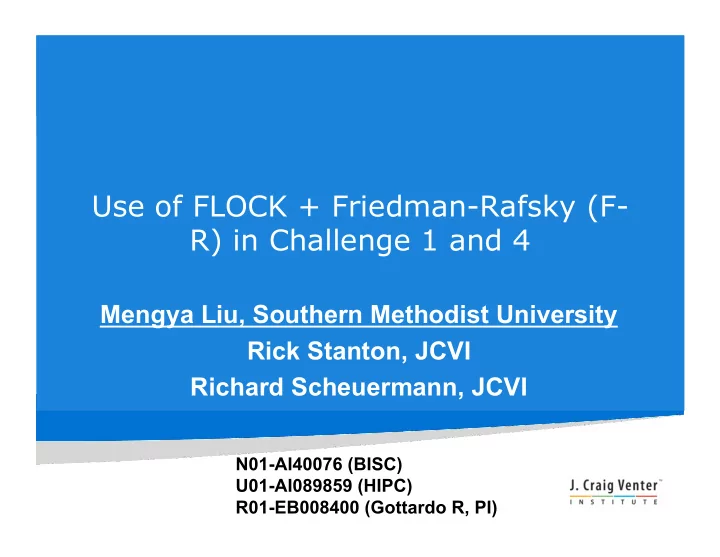

Use of FLOCK + Friedman-Rafsky (F- R) in Challenge 1 and 4 Mengya Liu, Southern Methodist University Rick Stanton, JCVI Richard Scheuermann, JCVI N01-AI40076 (BISC) U01-AI089859 (HIPC) R01-EB008400 (Gottardo R, PI)
General cross sample comparison challenge • Algorithms like FLOCK identify data clusters in multidimensional FCM data one file at a time • Would like to compare equivalent populations across multiple samples • Previous approach • Either select a "representative" sample as a template or concatenate data from multiple files • Generate centroid list using FLOCK • Cluster each sample file separately using centroid list • Problems associated with representative or concatenated
Friedman-Rafsky (F-R) algorithm concept • Multivariate generalization of Wald Wolfowitz (WW) run test • WW is a non-parametric statistical test to determine if two populations have the same distributions • Null hypothesis = both populations have same distributions • Label N total cells • m cells from populations A and • n cells from population B and combine • Sort • Test statistic is function of total runs R • Where R = N sequences of identical labels • Examples: • R = 2 for A A A A B B B B • R = 7 for A B A A B A B A • Null hypothesis rejected for small values of R
Friedman-Rafsky (F-R) algorithm concept – Minimal Spanning Tree Minimal Spanning Tree allows multivariate generalization (c) Remove edges linking (a) Pool samples of (b) Calculate Minimal Spanning Tree different samples two sets
F-R Advantages and Drawbacks Advantages: • Non-parametric method – no need for knowledge of distribution parameters • Ability to discriminate population characteristics that are tough to describe parametrically (skew, odd shapes) • Can provide feedback to automated gating algorithms when the number of populations is unknown. • Example, if two subpopulations in sample 1 are matched to one same subpopulation in sample 2, it indicates that either sample 1 is over-partitioned sample 1 or we didn't partitioned sample 2 enough. Drawbacks: • Computationally expensive, need to downsample
Implementation of the F-R algorithm For two samples: • Get the auto-gating results from FLOCK or any other auto-gating software • For every pair of populations, one from sample A and the other from sample B, • If either populations has more than 100 events (predetermined, changeable) • Take a random sample of 100 • Apply the F-R test to the sampled population(s) to obtain the p-value • Repeat 20 times (predetermined, changeable) • Calculate the averaged p-value • Repeat the procedure for all pairs and obtain the p-value matrix • Set up a predetermined cutoff to identify the matched pair (may need to adjust cutoff for different shifts)
Simulation of data to characterize performance Experimental data Simulated data
Movements of simulation of data to characterize performance
Movements of Simulation of data to characterize performance
Use of FLOCK + Friedman-Rafsky (F-R) in Challenge 1 and 4 FLOCK can be accessed via Immport website
Use of FLOCK + Friedman-Rafsky (F-R) in Challenge 1 and 4 Processing Steps • Identify populations with FLOCK • Map FLOCK populations to T Cell target populations for a representative T Cell sample (target = Stanford 1)
Use of FLOCK + Friedman-Rafsky (F-R) in Challenge 1 and 4 Processing Steps • Apply F-R algorithm to perform cross sample associations across the other samples.
Cross sample comparisons – challenge 4 T Cell data Target data set (Stanford 1) compared with other datasets using P Values from the F-R test
Future Directions Better accommodate differences in gains across instruments (shifts, dialations) Evaluate and incorporate lessons learned here at Flowcap III
Recommend
More recommend